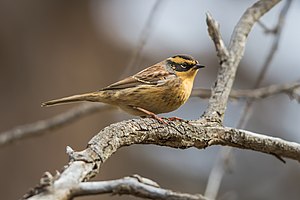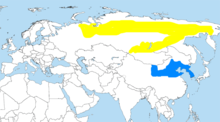Mountain brown
| Mountain brown | ||||||||||||
|---|---|---|---|---|---|---|---|---|---|---|---|---|

Bergbraunelle ( Prunella montanella ) |
||||||||||||
| Systematics | ||||||||||||
|
||||||||||||
| Scientific name | ||||||||||||
| Prunella montanella | ||||||||||||
| ( Pallas , 1776) |
The Bergbraunelle ( Prunella montanella ) is a passerine bird from the Braunelle family . It inhabits the mountain forests of Siberia from the Urals to the Chukchi Peninsula .
description
Appearance
The 13 to 14.5 cm long mountain brown ella is similar to the dunnage brown ella in size and habitus, but differs in its striking head markings. The top of the head is black-brown with a slightly lighter stripe on the top. It stands out clearly from an ocher-yellow, wide stripe over the eyes that extends down to the neck. The reins and ear covers, which form a clear mask, are also dark brown. The ocher yellow color continues on the throat, beard, neck and chest. On the sides of the neck there is an ash-gray spot that protrudes into the ocher-colored areas in an almost sickle-shaped manner towards the throat and clearly separates the neck and chest sides from one another. On the belly, the yellow ocher changes into a slightly paler beige to yellowish white, the sides are darkly striped. There is a dark cloud on the chest. The wings and tail are very similar to the dunnock, the under wing-coverts are pale ocher like the underside. The axillary feathers show a gray tinge.
A sexual dimorphism is only very weak. In the female, the dark brown of the head markings is much less intense, but this is not a sure distinguishing feature from the male. Due to plumage wear, both sexes decrease in the color intensity of the plumage in the course of the year, towards a somewhat grayish, paler appearance.
The feet are flesh-colored to yellowish brown, the bill black-brown with a brownish light base of the lower mandible. The iris of the Bergbraunelle is light brown.
voice
The song is very similar to that of the dunnock. The most common call is a ringing or whirring didi didi that a little of the reputation of the silk tail can remember.
Way of life, distribution and existence
It breeds in forests with a lot of undergrowth and on the banks of water. The nest is built in a shrub near the ground. It is made up of twigs, roots and grass and is lined with moss , hair and feathers . It is cup-shaped and has a deep hollow. The breeding season of the Braunelle extends from May to July. During this time, the female lays four to six blue-green to blue-gray eggs, which it incubates for about 11 to 12 days. Further details on reproduction are not known.
The bird picks invertebrates such as insects , spiders and larvae from the ground or catches them in flight and on trees. It also eats berries and seeds less often .
The Bergbraunelle occurs in the coniferous forests of the Taiga of Siberia . But it also inhabits thinly overgrown areas on the edge of the tundra and high mountains up to the tree line .
Their breeding area extends from the Urals eastward to the Chukchi Peninsula and in a thin band from Mongolia to Lake Baikal . In Scandinavia , the Baltic States , Italy , Iraq , Japan , Alaska and Western Canada it is an exception. It sometimes flies into the last three areas on its migration routes. It was first spotted in Germany and the Netherlands in October 2016 .
In September and October it moves south via Kazakhstan and Mongolia and winters in eastern China , northern India , Bangladesh , the western Himalayas , Korea and Pakistan . The withdrawal takes place around April.
The size of the European population is only 100 to 500 breeding pairs. Outside Europe, however, the population is likely to be significantly larger. At present there are no indications of a decline in populations or an increase in populations. The IUCN lists the Bergbraunelle as least concern .
Subspecies
There are two subspecies :
- P. m. montanella ( Pallas 1776) - Western Siberia to the lower Lena
- P. m. badia ( Portenko 1929) - Chukchi Peninsula
literature
- Urs N. Glutz von Blotzheim , Kurt M. Bauer: Handbook of the birds of Central Europe, Volume 10 / II: Passeriformes (1st part): Motacillidae - Prunellidae (HBV). AULA-Verlag 1985/2001, ISBN 3-923527-00-4 .
- Karel Šťastný: Birds Handbook and Guide to the Birds of Europe . Bechtermünz Verlag im Weltbild Verlag, Augsburg 1997, ISBN 3-86047-737-4 .
Web links
- Avibase
- Birdlife international
- Prunella montane ella in the endangered Red List species the IUCN 2008. Posted by: BirdLife International, 2008. Accessed July 10 of 2009.
- Videos, photos and sound recordings of Prunella montanella in the Internet Bird Collection
- Feathers of the mountain brown elf
